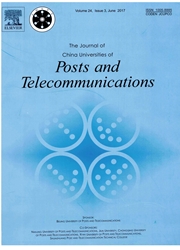

 中文摘要:
中文摘要:
一台哑的收音机和与普通接收装置同时交流的多重认知收音机被考虑的一种情形。在这份报纸,我们在两添加剂白人 Gaussian 噪音(AWGN ) 下面导出多重用户的认知多重存取的隧道(MUCMAC ) 的一个可完成的率区域隧道和 rayleigh 褪色隧道,由使用多重用户的联合弄脏编码的纸(DPC ) 和编码的重叠。通过认知,这被假定第二等的用户(怀疑) 能获得主要用户(PU ) 的消息非有原因地预先准备。用这个方面信息, SUs 能执行多重用户 DPC 从苏避免干扰。而且, SUs 能也分配他们的 transmit 力量的部分帮助 PU,用编码的重叠。因此,传统的多重存取的隧道(MAC ) 的能力区域能被扩大。而且,一些 asymptotic 结果作为数字被显示出怀疑增加。在 AWGN 盒子中, PU 的最大的可完成的率随数字的增加对数地成长,这被说明,在瑞利盒子中怀疑,我们证明认知获得将与隧道信号减少到噪音比率(SNR ) 增加。
 英文摘要:
英文摘要:
A scenario where one 'dumb' radio and multiple cognitive radios communicating simultaneously with a common receiver is considered. In this paper, we derive an achievable rate region of the multiple-user cognitive multiple-access channel (MUCMAC) under both additive white Gaussian noise (AWGN) channel and rayleigh fading channel, by using a combination of multiple user dirty paper coding (DPC) and superposition coding. Through cognition, it is assumed that the secondary users (SUs) are able to obtain the message of the primary user (PU) non-causally beforehand. Using this side information, the SUs can perform multiple user DPC to avoid the interference from the SU. Besides, the SUs can also allocate part of their transmit power to aid the PU, using superposition coding. Therefore, the capacity region of traditional multiple-access channel (MAC) can be enlarged. Moreover, some asymptotic results are shown as the number of SUs increases. In the AWGN case, it is illustrated that the maximum achievable rate of the PU grows logarithmically with the increase of the number of SUs, whereas in the Rayleigh case, we show that the cognitive gain will increase with the decreasing of the channel signal to noise ratio (SNR).
 同期刊论文项目
同期刊论文项目
 同项目期刊论文
同项目期刊论文
 Resource allocation for the cluster-based cooperative multicast in OFDM-based cognitive radio system
Resource allocation for the cluster-based cooperative multicast in OFDM-based cognitive radio system 期刊信息
期刊信息
